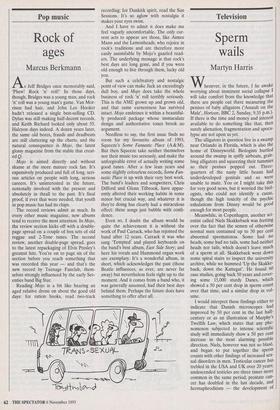Pop music
Rock of ages
Marcus Berkmann
As Jeff Bridges once memorably said, 'Phew! Rock 'n' roll!' In those days, though, Bridges was a young man, and rock 'n' roll was a young man's game. Van Mor- rison had hair, and John Lee Hooker hadn't released a single best-selling CD. Dylan was still making half-decent records, and Keith Richard looked only about 55. Halcyon days indeed. A dozen years later, the same old bores, frauds and deadbeats are still cluttering up the charts, and the natural consequence is Mojo, the latest glossy magazine from the stable that creat- ed Q.
Mojo is aimed directly and without shame at the more mature rock fan. It's expensively produced and full of long, seri- ous articles on people with long, sprious careers. It's uninterested in the future, notionally involved with the present and absolutely in thrall to the past. It's final proof, if ever that were needed, that youth in pop music has had its chips.
The record reviews admit as much. In every other music magazine, new albums tend to receive the most attention. In Mojo, the review section kicks off with a double- page spread on a couple of box sets of old reggae and 2-Tone tunes. The second review, another double-page spread, goes to the latest repackaging of Elvis Presley's greatest hits. You're on to page six of the section before you reach something that was recorded this year — and that's the new record by Teenage Fanclub, them- selves strongly influenced by the early Sev- enties band Big Star.
Reading Mojo is a bit like hearing an aged relative drone on about the good old days: for ration books, read two-track recording; for Dunkirk spirit, read the Sun Sessions. It's so aglow with nostalgia it makes your eyes swim.
And I have to admit it does make me feel vaguely uncomfortable. The only cur- rent acts to appear are those, like Aimee Mann and the Lemonheads, who rejoice in rock's traditions and are therefore more easily assimilable by Mojo's gnarled read- ers. The underlying message is that rock's best days are long gone, and if you were old enough to live through them, lucky old you.
But such a celebratory and nostalgic point of view can make Jack an exceedingly dull boy, and Mojo does take the whole business of rock 'n' roll terribly seriously. This is the NME grown up and grown old, and that same earnestness has survived intact. Mojo enshrines it within a beautiful- ly produced package whose immaculate design and authoritative tones brook no argument.
Needless to say, the first issue finds no room for my favourite album of 1993, Squeeze's Some Fantastic Place (A& M). But then Squeeze take neither themselves nor their music too seriously, and make the unforgivable error of actually writing some good tunes. After a few lean years and some slightly colourless records, Some Fan- tastic Place is up with their very best work. The band's leaders and songwriters, Chris Difford and Glenn Tilbrook, have appar- ently altered their working habits in some minor but crucial way, and whatever it is they're doing has clearly had a miraculous effect: these songs just bubble with confi- dence.
Even so, I doubt the album would be quite the achievement it is without the work of Paul Carrack, who has rejoined the band after 12 years. Carrack it was who sang `Tempted' and played keyboards on the band's best album, East Side Story; and here his vocals and Hammond organ work are exemplary. It's a wonderful album, in short, which acknowledges the past (those Beatle influences, as ever, are never far away) but nevertheless feels right up to the moment. And it comes from a band who, it was generally assumed, had their best days behind them. Perhaps the future does have something to offer after all.










































































 Previous page
Previous page